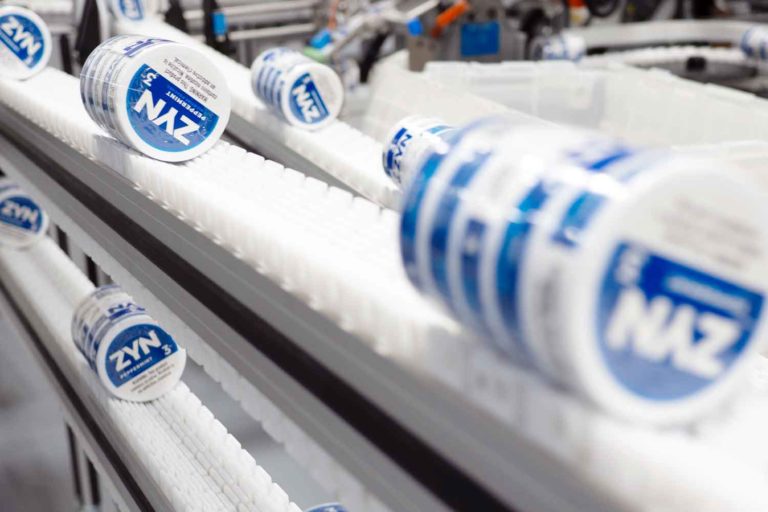
Some markets have been more receptive to modern oral products than others.
By Stefanie Rossel
The modern oral nicotine category continues growing but struggles to reach a wider global audience. Modern oral nicotine products, which are white, pre-portioned little bags comprising a nicotine-containing carrier material, are considered the advanced, cleaner version of Swedish snus, a pasteurized oral tobacco that is available as loose products or pouches and is credited with helping Sweden achieve its record-low smoking prevalence by offering smokers a less harmful way to consume nicotine.
According to Euromonitor International, global sales of nicotine pouches grew from 17.09 billion units in 2022 to an estimated 20.77 billion units in 2023. The overwhelming majority of sales, however, take place in the U.S., where an estimated 14.97 billion units were sold in 2023 compared to 12.61 billion units in 2022. Sweden ranks second, with 1.8 billion units sold in 2022 and an estimated 2.2 billion units sold in 2023. It is followed by Denmark with a forecast 745.3 million units in 2023 (versus 589.2 million units in 2022), Pakistan and Austria with estimated sales of 695 million units and 477 million units, respectively.
As far as value is concerned, Euromonitor estimates the category to be worth $10.29 billion globally, up from $8.47 billion in 2022. By 2027, the business intelligence firm expects the segment’s value to reach $15.99 billion. Despite their relentless expansion, modern oral nicotine products remain a niche within a niche—they are a small part of a larger oral tobacco market, which accounted for only around 2 percent of the global nicotine industry in 2022.

In the U.S., retail sales of nicotine pouches generated $8.58 billion in 2023 compared to $7.23 billion in the previous year. Raphael Moreau, head analyst at Euromonitor, expects the U.S. modern oral nicotine market to reach $11.03 billion by 2027.
“The U.S. has benefited from a solid legal framework, with the Food and Drug Administration controlling the market chain, requiring authorization to market, nicotine health warnings and premarket assessment,” Moreau says. “Generally, the U.S. has a strong tradition of oral, i.e., chewing, tobacco. This definitely helped. Nicotine pouches are convenient and discreet to use, and they are taking share from chewing tobacco and Swedish-style snus, which has boosted U.S. sales.”
As consumers become more familiar with the product, Moreau anticipates the market to continue growing rapidly. In 2023, just under 3 percent of the U.S. adult population consumed modern oral nicotine products. “Over the next five years, we will see an increase because of more awareness of the brands,” he says. “There is a wide flavor selection, which appeals to consumers who can’t use flavored vape products anymore as they are banned. The return to office work after the Covid pandemic will also contribute to the category’s growth: When working from home, people were more likely to vape. At the office, pouches are more convenient. Besides, the products are used as a cessation aid away from cigarettes and other combustibles.”
Moreau suspects that the majority of modern oral nicotine is used in combination with other tobacco products. “This also has caveats because potentially, consumers may just try them and not become regular users, so prediction is difficult,” he says.

(Photo: Swedish Match)
Zyn Pulls Further Ahead
With a 77 percent category retail value share in the third quarter of 2023, Zyn is the U.S. market leader by a large margin. Shipment volume of Zyn nicotine pouches amounted to 104.5 million cans during that period, a 65.7 percent increase compared to the third quarter of 2022, according to Philip Morris International. PMI became the owner of the Zyn brand through its acquisition of Swedish Match for $16 billion in late 2022. The move has given PMI a comfortable lead in the U.S. nicotine pouch market, where it previously had no presence to speak of, and will help the company to achieve its goal of becoming substantially smoke-free by 2023.
At PMI’s Investor Day Conference in September 2023, Lars Dahlgren, president of smoke-free oral products and CEO of Swedish Match, forecast “stellar growth” for the product also because Zyn is cheaper than cigarettes, retailing at $5 per can compared to a price of $8 for a pack of cigarettes. According to news platform Seeking Alpha, the brand is popular among Generation Z, which has otherwise been a hard market for traditional tobacco companies to crack.
In addition to Zyn, some other brands have made gains recently, according to Moreau. With a retail volume of 15.4 million units and a value share of 11 percent in 2022, Altria’s On! Brand ranks second behind the market leader, followed by Swisher International Group’s Rogue nicotine pouches, with 7.9 million units sold during that period.
The “attractive category dynamics” in the highly competitive U.S. nicotine pouch market also holds potential for new players. In June 2023, ITG Brands acquired a range of nicotine pouches from Canada-based TJP Labs in order to facilitate its entry into the U.S. modern oral market. Following further consumer testing, ITG Brands plans to launch 14 pouch product variants in 2024.
“The category still is very young, so there is no strong brand loyalty, and consumers are likely to try new brands,” comments Moreau. “This makes the market attractive to new entrants. And there’s quite a lot of room for them, as the category is growing very fast.”
Regulation Required
Except for the Nordic countries, where consumers have been familiar with snus for two centuries, the modern oral category is still underdeveloped in the rest of the world.
Japan Tobacco International, present in the segment with its brand Nordic Spirit, sees vast untapped potential. Nordic Spirit was developed in Sweden and has rapidly grown since its launch in 2018. The product is available in the U.K., Ireland, the Philippines and Switzerland. “While the tobacco-free nicotine pouches category is still in its infancy, we already see that many adult tobacco and nicotine consumers globally will be interested in trying the product, helping the new category to grow significantly over the coming years,” says a JTI spokesperson. “For example, smoke-free nicotine pouches have become increasingly popular in the U.K. Responding to this growing trend, the Nordic Spirit brand has witnessed growth and increased its market share to around 45 percent.”
According to Euromonitor, U.K. consumers bought 92.1 million nicotine pouches in 2022. In 2023, the category there grew 54.6 percent.
Pakistan, however, was the country with the largest year-on-year growth rate, with sales in 2023 expected to be 70.7 percent, up from the 127.8 million units sold in 2022. In Pakistan, an estimated 10 million people use smokeless tobacco, which corresponds to more than 40 percent of the country’s total tobacco market. In December 2022, BAT announced that its modern oral nicotine brand Velo, which it had launched in Pakistan in early 2020, had achieved a monthly volume of more than 40 million pouches in the country, making it the company’s third-largest market for nicotine pouches.
Most growth in the category will come from Asia-Pacific and Eastern Europe, according to Moreau. In Poland, for instance, the category increased by 69.5 percent in 2023. “The Czech Republic is also interesting because it had quite strong demand in 2022 and 2023,” Moreau says. “This is likely to stay [this way], particularly since nicotine pouches are regulated in the country now.”
In May 2023, Czechia’s Ministry of Health issued a decree, modeled on tobacco and e-cigarette legislation, which regulates the composition, appearance, quality and characteristics of nicotine sachets. It also defines the legal age for sale and requires manufacturers and importers of nicotine sachets to register their products with the Ministry of Health. The legislation entered into force on July 1, 2023.
Other countries, by contrast, have been less accommodating, with the Netherlands and Belgium banning modern oral products in April 2023 and October 2023, respectively. The European Commission, too, is reportedly mulling a ban on nicotine pouches for the common market. The products are also prohibited in Australia and New Zealand.
“History has repeatedly shown that bans of legal products often do not lead to their intended goals and instead encourage criminal gangs to increase supply of illegal products to make up for the shortfalls,” warns JTI’s spokesperson. “Instead of an outright ban, we should aim for an evidence-based regulatory framework that acknowledges the potential of nicotine pouches to reduce the risks associated with smoking. At the same time, we must ensure that oral nicotine products aren’t marketed or sold to minors under any circumstances.”
In Germany, modern oral tobacco continues to operate in a regulatory gray area. Nicotine pouches are classified as food in the country, which makes them subject to European food law. Because the EU has not approved nicotine as a food or food ingredient, this means that nicotine pouches cannot be legally traded in Germany.
Despite the German Federal Institute for Risk Assessment’s October 2022 acknowledgement that tobacco-free nicotine pouches could reduce the health risks compared to smoking, the products’ legal status remains unchanged. “It will only change after a decision at EU level,” says Moreau. “Germany is a typical case where an uncertain or hostile landscape and a lack of familiarity with the products are two negative factors that are feeding each other. Whenever the legal status is unclear, not exactly defined or restrictive, retailers will basically avoid selling them. Therefore, consumers will not be aware of the products, and they will not trust them. In Germany, nicotine pouches are still available online, but the products are obviously now not as widespread as [they would have been] if they were sold in stores.”


